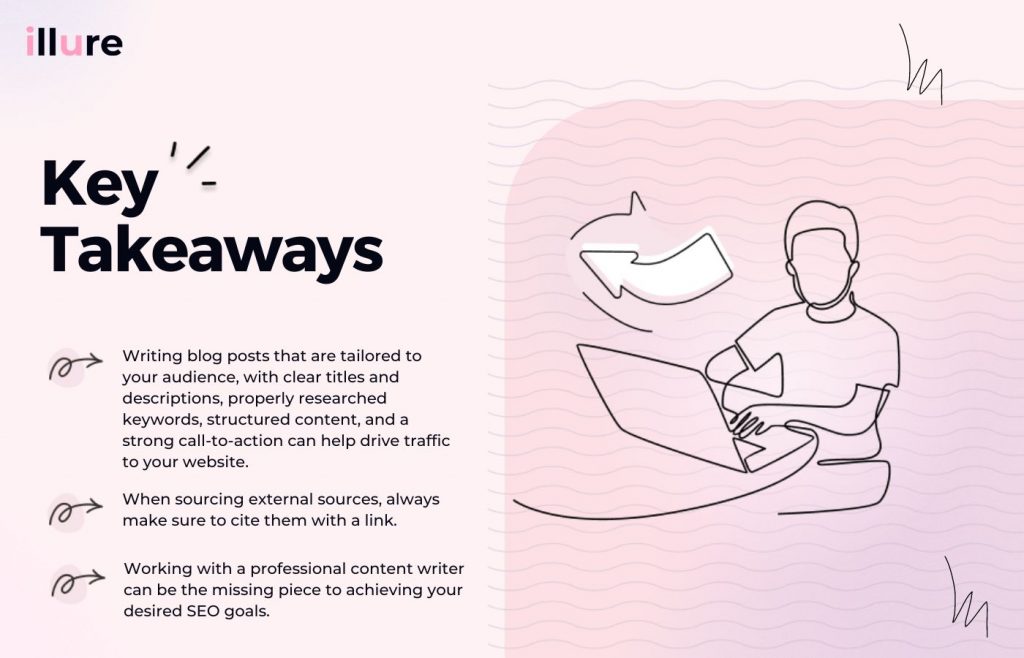Are you looking for a way to increase your website’s visibility and boost your search engine rankings? Writing SEO-friendly blog posts is one of the most effective ways to improve your company’s SEO.
Content is still king when it comes to SEO, so it’s important to create content that is both informative and search engine friendly. In this blog post, we’ll discuss how to write SEO-friendly blog posts that drive traffic to your website. We’ll cover topics such as keyword research, using the right keywords, optimizing titles, and making sure your content is useful and relevant.

Keep Your Audience in Mind Always
When it comes to content writing and blog posts, SEO is important, but your audience should be your top priority. Writing for SEO without considering your audience won’t benefit you in the long run. Before you begin writing, consider who you’re writing for. Who are you trying to reach? Ask yourself questions like, what are their needs? How can you solve their problems? What would make them want to read your content?
Once you know who you’re writing for, you can tailor your content to meet their needs and interests. Think about what topics they might be interested in and use keywords that are relevant to those topics. Doing so will help your readers find your content more easily. Additionally, make sure to keep your language simple, clear, and concise. This will help readers understand and appreciate your message better.
Finally, when creating content and blog posts, focus on quality over quantity. You want each piece of content to add value to your readers’ lives. The more value you offer, the more likely your readers are to come back for more. So focus on providing helpful and interesting content that solves a problem for your readers and helps them in some way.

Conduct Keyword Research
When it comes to writing content that will boost your company’s SEO, keyword research is essential. It can help you understand what words and phrases potential customers are using to search for businesses like yours, giving you a better chance of appearing in their search results.
To begin your keyword research, start by brainstorming a list of words and phrases related to your business and the topics you’d like to cover in your blog posts. You can also use a keyword research tool like Google Keyword Planner to find out which terms are most searched in your industry. Once you have identified the most popular keywords related to your business, make sure you incorporate them into your content in a natural way.
You want to avoid keyword stuffing at all costs. Be sure to focus on long-tail keywords and phrases as they are more specific and are often easier to rank for than generic terms. When you optimize your content with targeted keywords, you’ll give your post a better chance of appearing higher up in search engine rankings.
Work with Us
At Illure, we specialize in crafting quality blog posts that capture attention and get results. Our team of expert writers create content that’s optimized for search engine visibility as well as readability by humans. We’re up-to-date on the latest SEO trends so you don’t have to worry about constantly reworking your website or monitoring keyword performance.Our team works closely with you to understand what makes your business unique and will develop custom strategies to boost visibility, generate leads, and increase conversions. From performing keyword research to optimizing headings and meta tags – our team has the experience and knowledge to bring your brand to the next level.With our comprehensive services, we’ll work together to create an effective roadmap for boosting website visibility and increasing organic traffic!

Structure Your Content Effectively
One of the most important elements of any successful blog post is having a good structure. Structure makes it easier for readers to find the information they’re looking for, and can even help boost your SEO rankings. Here are some tips for structuring your blog posts.
Start with a catchy headline: Your headline should grab readers’ attention and make them want to read more. Make sure your headline is clear and concise so that readers know what your post is about.
Write an engaging introduction: Start by introducing your topic and providing a brief overview of what you’ll cover. This will give readers a better idea of what to expect from the post.
Create subsections: Break up your content into easy-to-read subsections. Use headings, subheadings, and bullet points to guide readers through the post. This helps readers skim through the text quickly, as well as break up long paragraphs.
Include visuals: Adding visuals such as images, videos, infographics, or charts can help to keep readers engaged and make your post more visually appealing.
Link out: Include external links throughout your post that point to other sources of information. Not only does this provide readers with additional resources, but it can also help improve your SEO rankings.
Include a call to action: Be sure to include a call to action at the end of your post. This can be as simple as asking readers to leave a comment, share the post on social media, or sign up for a newsletter.
By following these tips, you can ensure that your blog posts have a strong structure that makes them easy to read and navigate. This not only helps you attract more readers, but can also help boost your SEO rankings.
Don’t Forget Meta Titles and Descriptions
Meta titles and descriptions are an essential part of any successful SEO strategy. They help search engines identify what your page is about, and they can also be used to improve your click-through rate from search engine results pages.
Your meta title should accurately reflect the content of your page and be no more than 60 characters long. It should include your target keywords so that the search engine can understand what your page is about. You can also use the target keywords in the meta description, which should be no more than 160 characters long.
The meta description should provide a concise summary of the content on the page so that readers are encouraged to click through and read more.
However, it’s important to remember that the main goal of your meta title and description is to accurately reflect the content of your page. If you don’t have relevant content to back up your titles and descriptions, then search engines may penalize you for keyword stuffing.
By following these best practices for meta titles and descriptions, you can ensure that your pages are optimized for search engines and will attract more visitors.
Work with a Professional SEO Content Writer.
Are you looking for help with content writing and blog posts to boost your company’s SEO? Here at illure, our team of professional content writers can craft quality content that drives traffic and increases your website’s visibility in the search engine results.
From performing keyword research to optimizing headings and meta tags – our team has the experience and knowledge to bring your brand to the next level. With our comprehensive services, we’ll work together to create an effective roadmap for boosting website visibility and increasing organic traffic!
Focus on your CTA
Creating content for your blog is just the first step in improving your SEO. Once you’ve published the post, you need to make sure that you are driving traffic to your site. This is where calls to action (CTA) come into play. A call to action is a statement or phrase that encourages readers to take a desired action. CTAs should always be used in blog posts as they provide direction to readers and help convert them into customers.
When creating CTAs, it’s important to think about your reader’s needs. What do they need to do to get what they want? Your CTA should be clear and concise, and give readers a sense of urgency. Try to avoid generic phrases like “click here”, as this won’t be specific enough for your readers. Instead, use phrases like “Sign up today” or “Find out more here”.
It’s also important to make sure that your CTA is visible and stands out from the rest of the text. You can do this by using bold, italicized text or even inserting images or videos. It’s important to make sure that your CTA is prominent and easy to find, as this will increase the chances of readers taking the desired action.
Finally, make sure that your CTA is linked to a page on your website that is relevant to the content. For example, if you are discussing a particular product or service, link the CTA to a page on your website that provides more information about that product or service. This will make it easier for readers to take action and will help improve your website’s overall SEO.
In summary, calls to action are essential for driving traffic and improving SEO on your blog. Make sure that your CTAs are clear and visible, and link them to relevant pages on your website. By doing this, you will be able to increase the chances of readers taking action and ultimately improve your SEO.
Use external sources. Always cite your sources with a link.
Including external sources to your blog posts is a great way to strengthen your content and boost your SEO. When referencing external sources, make sure to link back to the original page, as this will help you rank better in search engine results. It is also important to give credit to the authors of the original material by providing a citation.
When linking to external sources, it’s a good idea to link to pages with high domain authority (DA). DA is a metric used to measure how trustworthy a website is, and pages with higher domain authority usually have higher rankings in search engine results.
You can use tools like Open Site Explorer and MozBar to check a website’s domain authority. It’s important to note that some sources might be unreliable, so make sure you research the source and check its credibility before linking to it.
Using external sources will not only boost your SEO, but also provide valuable information to your readers. This can help establish yourself as an authoritative source on the topic and improve the overall quality of your blog post. Citing your sources is also essential for avoiding plagiarism, which can lead to serious consequences.

Promote Your SEO Content
Once you’ve written and published your blog post, the work is far from over. You need to promote it if you want to get the most out of it. Here are some tips to get the most out of your content:
Social Media – Make sure to share your post on all of your social media accounts. You can also consider boosting your posts with a small budget to get more eyes on them.
Email Marketing – Send an email to your list about the new blog post you just wrote. Include a link to the blog post in the email and let them know why they should click it.
Reach Out to Influencers – Reaching out to influencers in your industry can be a great way to get the word out about your post. When you reach out, include a link to your post, and let them know why their followers might be interested in it.
Answer Questions – Answer questions on sites like Quora, Yahoo! Answers and Reddit that are related to the topic of your blog post. Make sure to include a link to your post when appropriate.
Comment on Other Blogs – Comment on other blogs that are in the same space as yours. You can also include a link back to your post, but make sure it’s relevant to the conversation.
No matter what methods you choose to promote your content, make sure you’re consistent. If you’re not getting any traction after a few weeks, try different strategies or adjust the content of your post to see if you can get better results.
Monitor your SEO Results
It’s all well and good to create a blog post that’s optimized for SEO, but if you don’t monitor the results, you won’t know whether or not it’s been effective. A key part of any content writing strategy is tracking your progress.
One of the simplest ways to track your results is to measure the number of clicks and views your blog post receives. This will give you an indication of how popular the post is and how much engagement it’s generating.
You can also track the amount of organic traffic your post generates by using Google Analytics. This will tell you how many people are visiting your post from search engines. You can then use this data to identify which keywords and phrases you need to focus on more in future posts.
Finally, don’t forget to check your blog post comments section. Reader feedback can give you valuable insights into what people liked and disliked about your post. It’s also a great way to engage with your readers and build relationships with them.
By monitoring your results, you’ll have a better understanding of what works for your audience and what doesn’t. This information can be used to refine your content writing and SEO strategies for future posts. With a bit of time and effort, you can ensure that all your blog posts are successful in driving traffic and engaging readers.

Some key takeaways for reaching a wider audience through SEO-friendly content include;
– Writing blog posts that are tailored to your audience, with clear titles and descriptions, properly researched keywords, structured content, and a strong call-to-action can help drive traffic to your website.
– When sourcing external sources, always make sure to cite them with a link.
– After you’ve published your content, promote it and monitor your results.
– Working with a professional content writer can be the missing piece to achieving your desired SEO goals.
Content Writing Agency for Your Business
Work with Illure to boost your content writing strategy for SEO. We start by understanding your business goals and creating a strategy that incorporates your target audience and keywords. Our experts then research the latest trends and use their creative skills to create captivating, SEO-friendly content that resonates with your target audience.Our content writers are experienced in writing for various industries, including B2B, eCommerce, and financial services. We also provide editorial services such as copyediting and proofreading to ensure your content is accurate and error-free.
Whether you need blog posts, web content, product descriptions, or press releases, our experienced team of professional content writers can handle it all. Contact us today to learn more about how our content writing services can help you boost your company’s SEO and drive traffic to your website.







